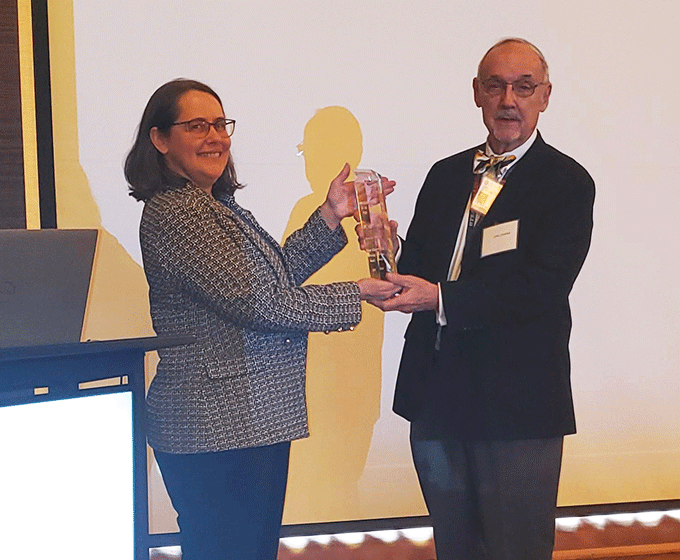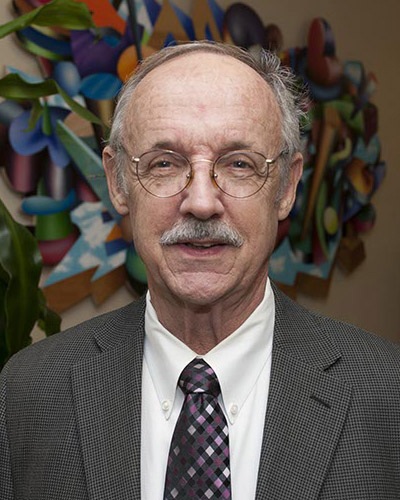
Christine Burke presented James Chambers with the Innovator of the Year award at the ceremony for UTSA’s 2024 Innovation Awards.
DECEMBER 17, 2024 — Winners of UTSA’s annual Innovation Awards were recently announced, in recognition of their substantial contributions to the university's research and development ecosystem through patents, licensing agreements, participation in the National Science Foundation's I-Corps program and induction into the National Academy of Inventors. A total of 40 people were recognized at the event. Among the awardees, biochemist James Chambers, a professor in the UTSA Department of Molecular Microbiology and Immunology, was named 2024 Innovator of the Year.
“UTSA is a catalyst for innovation, fostering a vibrant community of research and development that is dedicated to discovery and impact,” said Christine Burke, director of the Office of Commercialization and Innovation (OCI). “Our researchers have exceptional creativity and drive to build transformative technologies that benefit society, and that’s evident in the over three dozen awardees we celebrated this week.”
The UTSA Innovation Awards recognize innovation excellence annually in four categories representing key indicators of UTSA’s success at commercializing innovations. These include:
In addition to these awards, new members of the National Academy of Inventors (NAI) were also honored.
Andrew Mass, associate vice president for research – innovation & ecosystem development at Louisiana State University, was the keynote speaker at the event.
 James Chambers
James ChambersJames Chambers’ research and academic accomplishments include publishing 165 peer-reviewed journal articles in top-tier journals, securing over $10 million in grant funding from a variety of federal agencies and private sector sponsors, and numerous teaching awards, academic honors and designations, including Fellow of the American Association for the Advancement of Science (AAAS).
Chambers is an internationally recognized biochemist with multiple patents that have benefited public health and safety. In 1988, he created the first-ever sensor that detects chemical agents and toxins on the battlefield, earning him the U.S. Army’s Distinguished Service Award. Later, he developed a test to identify the threat agent Francisella (for which he received a patent in 2011) and helped create a viral transport medium used globally for rapid COVID-19 testing in 2020-2021.
Chambers is one of three founders of the Phage Refinery, a company dedicated to screening and isolating environmental phages. A phage, or bacteriophage, is a virus that infects and kills bacteria. Researchers use these isolated viruses to create therapeutics for bacterial pathogens that have developed drug resistance.
This year, UTSA recognized inventors who together garnered 11 issued patents including:
The following innovators had optioned or licensed technology during 2024:
This year, two UTSA faculty members were inducted as senior members into the National Academy of Inventors:
Additionally, Stanton McHardy, Chemistry, has been elected as a fellow of the National Academy of Inventors in the class of 2024.
Several faculty and staff members, students and industry mentors participated in the National Science Foundation’s I-Corps™ program. Through this accelerator program, a research team is mentored through the customer discovery process in order to better understand market needs and business best practice. To date, UTSA has sent 20 teams to national I-Corps cohorts. This year’s team is a flipped team, meaning the company has already formed, and they have already received Small Business Innovation Research (SBIR) or Small Business Technology Transfer (STTR) funding:
Enova Concepts
William Paul Flynn | Technical Lead
Sean Garnsey | Co-Technical Lead
Matthew Trippy | Entrepreneurial Lead
Kaitlyn Bloch | Mentor
The OCI works with faculty to facilitate technology transfer and commercialization and to establish and strengthen university-industry partnerships. The team manages a portfolio of over 350 technologies, primarily in cyber, biosciences and medical devices, and advanced materials. In FY 2024, it filed 48 patent applications and prosecuted 11 patents to issuance. Additionally, it received 34 technology disclosures and four licenses/options.
“This year we celebrate 10 years at UTSA of I-Corps changing how inventors think about the potential of their technology,” Burke said. “From the customer discovery research of I-Corps to transformative team-based mentoring offered by our local Venture Mentoring Service and our New Venture Incubator and state-of-the-art wet lab start-up space, UTSA provides essential resources that enable inventors and start-ups to flourish.
UTSA Today is produced by University Communications and Marketing, the official news source of The University of Texas at San Antonio. Send your feedback to news@utsa.edu. Keep up-to-date on UTSA news by visiting UTSA Today. Connect with UTSA online at Facebook, Twitter, Youtube and Instagram.
Move-in Day is an exciting time for incoming students. Students living in Chaparral Village move in from August 20-21. The UTSA Housing and Residence Life (HRL) team looks forward to welcoming you all and helping you settle into your room.
Chaparral VillageMove-in Day is an exciting time for incoming students. Students living in Laurel Village move in on August 22. The UTSA Housing and Residence Life (HRL) team looks forward to welcoming you all and helping you settle into your room.
Laurel VillageThe College of Sciences welcomes our newest Roadrunners to UTSA at VIVA Science! This interactive event connects students with faculty, staff, student leaders, and peers while highlighting the opportunities available across the College.
Outdoor Learning Environment 2 (OLE), Flawn Building, Main CampusWe're excited to welcome the new class of UTSA College of Liberal and Fine Arts (COLFA) students to campus! Move In To COLFA is strongly recommended for new students in COLFA because it gives you the chance to learn about the Student Success Center, learn how to do college successfully and meet new friends.
Galleria (MH 2.01), McKinney Humanities Building, Main CampusBuild connections with your Alvarez College of Business peers and learn more about the Career Compass program! This opportunity will provide fun interactions, giveaways and a chance to meet your next friend!
Richard Liu Auditorium (BB 2.01.02,) Business Building, Main CampusCelebrate the end of summer and the start off a great fall semester with The Housing Block Party! This event will have live music, carnival-style treats, artists, games, and activities galore. Come and join us for a night of fun!
Multipurpose Room/Lawn, Guadalupe Hall, Main CampusBe part of an unforgettable night as SOSA takes the field for its first public performance of the season! Experience the power, pride, and pageantry of UTSA’s marching band. Learn beloved traditions, practice cheers, and feel what it means to be a Roadrunner.
Campus Rec FieldsThe University of Texas at San Antonio is dedicated to the advancement of knowledge through research and discovery, teaching and learning, community engagement and public service. As an institution of access and excellence, UTSA embraces multicultural traditions and serves as a center for intellectual and creative resources as well as a catalyst for socioeconomic development and the commercialization of intellectual property - for Texas, the nation and the world.
To be a premier public research university, providing access to educational excellence and preparing citizen leaders for the global environment.
We encourage an environment of dialogue and discovery, where integrity, excellence, respect, collaboration and innovation are fostered.